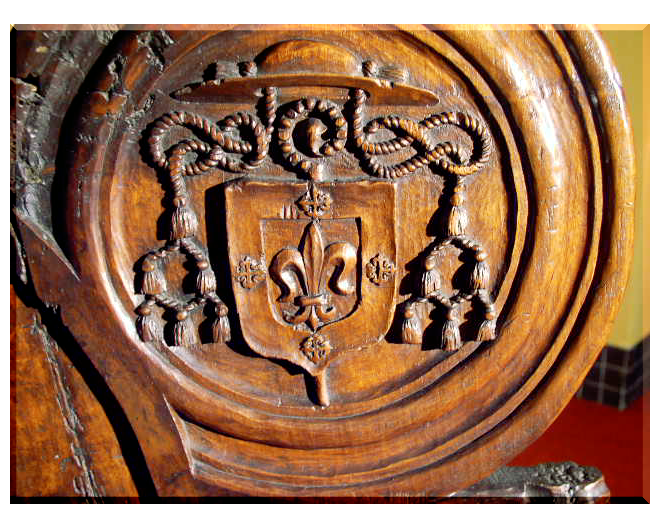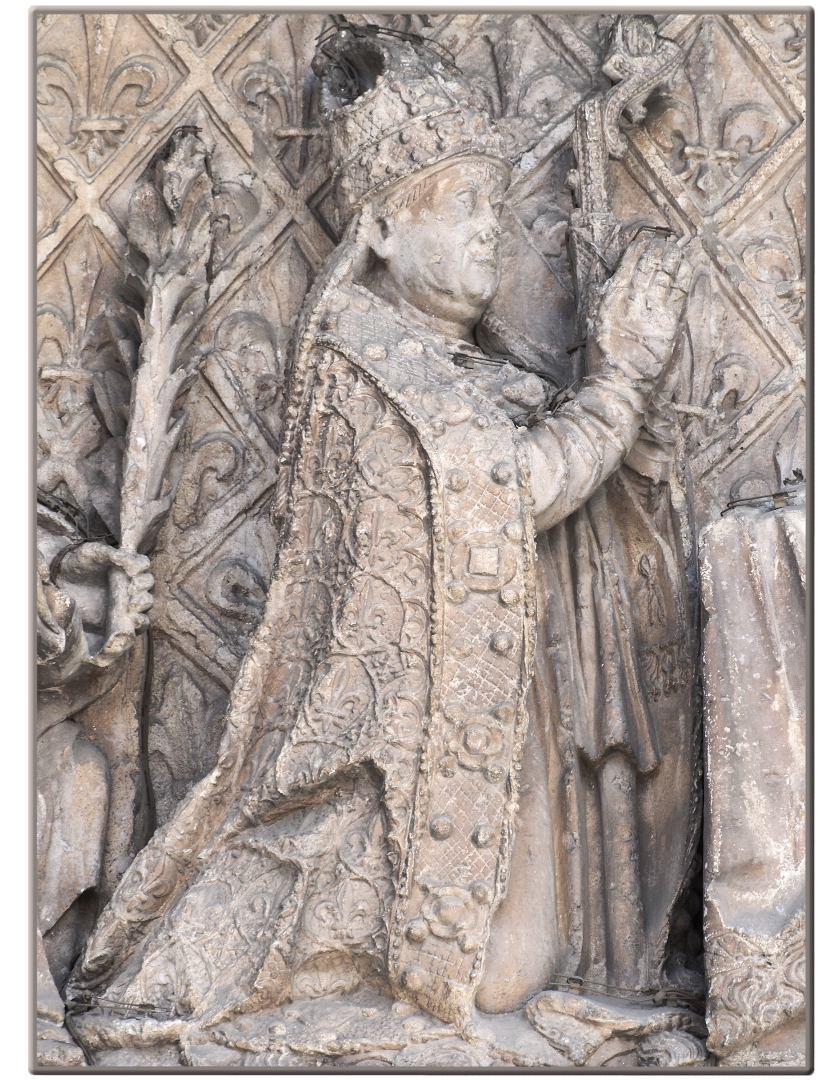The Visitation
Johann Friedrich Overbeck
Below the image, click play to listen.
Benjamin West, P. R. A.
Below the image, click play to listen.
To learn more about the entire series to which this painting belongs, visit here.
Glass, a practical material as well as an artistic art form, was first created more than a thousand years before the Romans conquered the world. Even though the Romans did not invent the scientific process of creating glass, they are recognized as skilled craftsmen in the art.
Roman glass like the uniquely shaped forms in M&G’s Bowen Collection of Antiquities begs the viewer to study ancient glass. What makes it iridescent? What was it used for? Was it just for the wealthy?
The word iridescence is defined by Merriam-Webster as “a lustrous rainbowlike play of color caused by differential refraction of light waves (as from an oil slick, soap bubble, or fish scales) that tends to change as the angle of view changes.” M&G’s Roman glass did not begin as an iridescent piece. The iridescent effect was created by the slow decomposition of the glass over time. The alkali in the glass was drawn out and then mixed with the water within the soil in which it was buried, thus leaving colorful hues on the outside of the glass.
Roman glass bowls and bottles were used to hold precious liquids: oils, perfumes, ointments, cosmetics, medicine and perhaps tears of a grieving loved one. While some speculate that tear bottles were not actually used to capture a grieving person’s tears, Scripture gives credence to the idea in Psalm 56:8, “Thou tellest my wanderings: put thou my tears into thy bottle: are they not in thy book?” The romance of capturing one’s tears only makes the bottle all the more mysterious and beautiful.
Roman glass was readily available and affordable for the common person to own—so prevalent, that third-century Emperor Gallienus refused to drink from a glass “because nothing was more common.” However, Emperor Tacitus who followed Gallienus’s reign “took great pleasure in the diversity and elaborate workmanship of glass.” These beautiful glass receptacles might have once been owned by a slave, plebeian, patrician, or emperor. Regardless, though, ancient examples of glass are well preserved and have turned more beautiful over time.
To view Roman glass from the Bowen Collection of Antiquities, visit The Museum of the Bible in Washington DC, where many M&G antiquities are currently on loan.
Angie Snow, Museum Educator
Published in 2019
Walnut
Spanish, mid 15th century
A chair, from the English chaere or Latin cathedra, is one of the most common pieces of furniture and easily identified in its simplest form by its parts—back, seat, arms and legs. The chair’s specific purpose can be discerned by more descriptive names such as recliner, wheelchair, throne, etc. Of course, the person “who takes a seat” can further outline the chair’s scope such as the Queen of England positioned in The Chair in the House of Commons to open a new session of Parliament, a ruling monarch seated on a throne to make a solemn declaration, or a bishop (such as the Pope, known as the Bishop of Rome) adopting a position in a cathedra or cathedrae apostolorum (as it occurs in early church writings) to teach with apostolic authority.
The Museum & Gallery’s furniture collection from the fourteenth to sixteenth centuries is known as the most extensive representation in America and includes several types of ecclesiastical chairs, four of which are cathedrae. Each of the four has interesting designs and carvings, but the oldest in the collection possesses by far the most intriguing and traceable features.
Gazing from the back panel of the Cathedra is a sculpted female figure representing St. Lucy, one of the most venerated female saints in martyrology and mentioned in the Catholic mass itself. She holds two objects: a palm frond, symbolic of victory in death and a platter with eyes, her most common and legendary attribute.
Just under the seat panel is a misericord. Since many of the medieval and early Renaissance ceremonial prayers were uttered in a standing position, the misericord acted as a place to “rest” or lean on during the long ceremony thereby allowing the bishop to obtain a type of “mercy.”
 This Spanish Cathedra dates with certainty to the 1400s due mostly to the identifiable coat of arms of Bishop Alonso de Burgos, born in 1415 in Burgos, Spain, the capital of Old Castile. The galero or pilgrim’s hat and tassels were common elements of the crest of a bishop, with the center shield denoting a particular symbol of heritage or character, in this case a lily in the stylized form of a fleur-de-lis, which is a symbol of purity. Alonso’s influence as a bishop was widespread as he served in the central Spain dioceses of Cordoba, Cuenca, and Palencia. Ordained as a Dominican monk at an early age, Alonso so earnestly and diligently applied himself to his vocation as a Catholic clergyman that he was readily noticed and subsequently assigned as confessor by the renowned Catholic Monarchs, a collective term for Spanish King Ferdinand II and Queen Isabella I, under whose banner Columbus sailed.
This Spanish Cathedra dates with certainty to the 1400s due mostly to the identifiable coat of arms of Bishop Alonso de Burgos, born in 1415 in Burgos, Spain, the capital of Old Castile. The galero or pilgrim’s hat and tassels were common elements of the crest of a bishop, with the center shield denoting a particular symbol of heritage or character, in this case a lily in the stylized form of a fleur-de-lis, which is a symbol of purity. Alonso’s influence as a bishop was widespread as he served in the central Spain dioceses of Cordoba, Cuenca, and Palencia. Ordained as a Dominican monk at an early age, Alonso so earnestly and diligently applied himself to his vocation as a Catholic clergyman that he was readily noticed and subsequently assigned as confessor by the renowned Catholic Monarchs, a collective term for Spanish King Ferdinand II and Queen Isabella I, under whose banner Columbus sailed.
 Beyond being instrumental in the financing of some of the voyages of the discoverer, Bishop Alonso’s influence was exhibited in founding a center for Dominican study, the Collegio de San Gregorio, an Isabelline-style building located in the city of Valladolid. Readily visible throughout the architecture is Alonso’s heraldry.
Beyond being instrumental in the financing of some of the voyages of the discoverer, Bishop Alonso’s influence was exhibited in founding a center for Dominican study, the Collegio de San Gregorio, an Isabelline-style building located in the city of Valladolid. Readily visible throughout the architecture is Alonso’s heraldry.
Bonnie Merkle, M&G Docent and Database Manager
Published in 2019
Oil on canvas
German, 1789-1869
Friedrich Overbeck began art instruction at age 15 under the tutelage of Joseph Nikolaus Peroux. He then learned from artists in Hamburg and through close study of Italian Renaissance works on display. The move to Vienna in 1806 enabled him to study at the Akademie and learn the principles of drawing in the academic tradition. This traditional approach, however, led him to reject those principles and adopt the teachings of Eberhard Wächter, particularly in the area of moral tone. One of the fascinating concepts about the sister arts (writing, drawing, music, and sculpture) is that principles from one art often apply to another. So, the idea of moral tone, usually applied to literature, is quite appropriate to discuss in the area of painting. Overbeck infused his religious beliefs into his beginning work in oils, an emphasis which became a hallmark of his work, especially following his 1813 conversion to Roman Catholicism. His family heritage was religious as well; the three previous generations of men in his family were ministers. It was Friedrich who broke with the family calling.
Although, it would be wrong to say that he abandoned the ministry; his works “preach” in merely another medium. In 1809 he and friends began the group Brotherhood of St. Luke, also known as the Nazarenes. Living in an abandoned monastery and adopting a biblical style of hair and dress led to “Nazarene” becoming a derogatory term. The Brotherhood’s motivation to reject the sensuality and artistic virtuosity of artists beginning in the sixteenth century was accompanied by a belief that all art should serve a moral purpose. Their work emphasizes Christian symbolism and bright clear colors which are hallmarks of the later Pre-Raphaelite Brotherhood members such as William Holman Hunt and Frederic James Shields.
While Overbeck embraced the art before Raphael, he also admired Raphael’s style. A look at The Visitation drawn c. 1517 by Raphael (in the Prado since 1837), suggests that Overbeck may have seen the master’s composition. The headdress of Elizabeth is strikingly similar to that in Overbeck’s painting as is the hairstyle of the Virgin. But there are purposeful differences as well. Raphael’s Virgin has no ornamentation on her dress; however, Overbeck chooses to give Mary a gold band of ribbon or lace, contrasting her gown with the matronly garb of her elderly cousin, Elizabeth, and showing her superiority.
Overbeck also indicates Mary’s elevated position as the mother of the Lord Jesus Christ through the physical positioning of the figures. Though Elizabeth is heavily pregnant at the time of Mary’s visit, she is positioned kneeling toward her younger relative. Luke 1:39-56 details the interaction between the women. Filled with the Holy Spirit, Elizabeth proclaims a three-fold blessing on Mary: she is blessed as a chosen woman, she is carrying the blessing of mankind’s Savior, and she is blessed for her faith in the promise of the Lord through Gabriel. Then Luke records Mary’s praise of the Lord, the Magnificat. Appropriately enough, Elizabeth gazes into the distance while Mary looks heavenward in a sign of her understanding of the privilege and position she has been accorded by God. John’s movement in Elizabeth’s womb at the arrival of his Lord is undoubtedly one of those things that Mary will keep and “ponder in her heart.”
In another work, Overbeck features Mary and her cousin, Mary and Elizabeth with Jesus and John the Baptist. The title indicates the characters in the painting; yet the accepted iconography and religious symbolism of the time provides clear and immediate identification. Mary is found in her blue robe holding her missal. John the Baptist wears his clothing of camel’s hair and grasps a sheep, signifying his task of proclaiming that his cousin Christ is the “Lamb of God.” Christ, sitting on the lamb, could not be more closely identified as that “Lamb.” In addition, He holds John’s cross-shaped staff indicating the manner in which the “Lamb of God” will be sacrificed for the sins of the world. The background of this painting is more reminiscent of Raphael’s work with its Italian landscape; such scenery suits this family portrait. However, Mary’s Magnificat focuses on the Lord God, so this portrait-like composition of The Visitation directs the viewer’s attention to her message by eliminating a distracting setting.
Overbeck’s biographer, Joseph Beavington Atkinson (1822-1886) records the artist’s mission in life: “Art to me is as a harp of David, whereupon I would desire that psalms should at all times be sounded to the praise of the Lord.” The sacred mood and expression of Christian piety, the beautiful colors, and the clean lines found in The Visitation fulfill his mission well.
Dr. Karen Rowe, M&G Board Member and Volunteer Membership Coordinator
Suggested Reading: Overbeck by Joseph Beavington Atkinson
Published in 2018